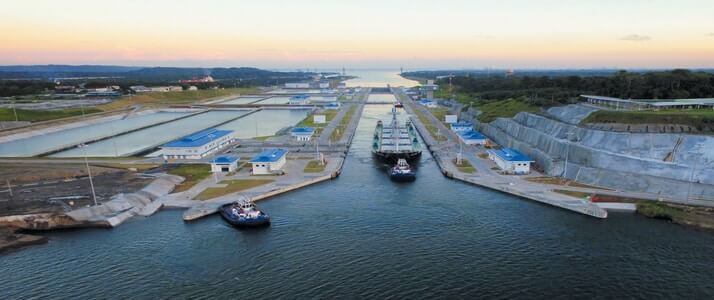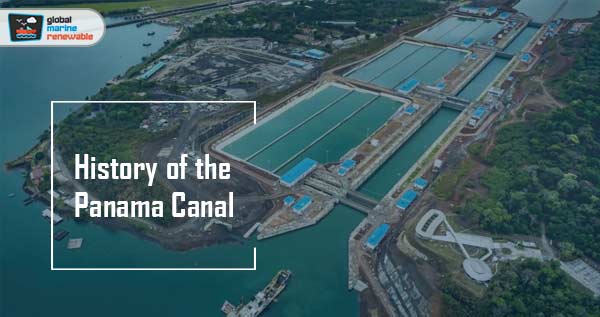
The Panama Canal is a large canal connecting the Pacific and Atlantic oceans.
It is considered one of the preeminent engineering work, but it also expresses the United States’ aggressive foreign policy.
The United States constructed it in order to find a route between the two oceans.
Everything began in the 16th century.
Table of Contents
History of the Panama Canal
Since Europeans realized that Columbus had discovered a ‘new world’ and not a route to Asia, explorers became amazed at the idea of finding a connection between the Pacific and Atlantic Oceans.
Ferdinand Magellan had made a route in which was required sailing south along the Atlantic Ocean, going around the south of South America, and moving up the Pacific Ocean on the western side of South America.
This route was impractical. On the other hand, other explorers searched for the Northwest Passage, the supposed water route in North America that connected the Pacific and the Atlantic Ocean.
However, these efforts were worthless because this route has never existed.
After evaluating the time it took to arrive at the ports of Spain, it was suggested in 1524 by Charles V, that by cutting out a piece of land somewhere in Panama, the trips would be shorter.
This way, the danger of taking the treasures through the cape would rationalize such an enterprise.
In 1534, a Spanish man suggested a route which was close to the now present canal, but as the time passed by, he abandoned his interest in it.
Various surveys were made between 1850 and 1875 showed that only two routes were practical, the one across Panama and another across Nicaragua.
The new Panamanian government authorized French businessman Philippe Bunau-Varilla, to make a deal with the United States.
Then, Hay-Bunau-Varilla allowed the U.S. to build the Panama Canal and provided them permanent control of a five-mile zone on either side of the canal.
Although the French had attempted construction of a canal in the 1880s, the Panama Canal was successfully built from 1904 to 1914.
The first three years were spent in the expansion of construction facilities.
The residents of the Canal Zone were primarily U.S. citizens and West Indians who worked in the area.
The one who became the first to make the traverse was a French boat called “Alexandre La Valley” on 1 April 1914.
That was the day when the construction was officially completed. The canal was opened on August 15, 1914, and its formal dedication was on July 12, 1920.
How Does the Panama Canal Work FAQ
The history of Panama is huge, and it is obvious that you will have questions regarding it.
We are discussing it in brief, so we escaped the elaborations and went with quick answers below.
Q1. Was the first attempt made by Americans?
No. French people were the first ones on trying to build the canal, but their efforts were worthless.
Q2 . Who owns the panama canal?
Panama canal is owned by Panama.
Q3 .How many workers died while constructing Panama canal?
12,000 workers (estimated)
Q4. Why French people didn’t have success in constructing the canal?
Because they tried to build it on rainy days, making the construction nearly impossible.
By the time passed by they had to give up losing many workers for getting diseases and injury reasons.
Q5. How many hours does it take to pass through it?
It takes approximately fifteen hours to traverse the canal.
Q6. When did French engineers start the construction?
It began on January 1, 1881.
Q7. Which diseases were they combating by that time?
Principally malaria and yellow fever.
How the Canal Works?
The Panama Canal has its advantages and disadvantages. One of the good things is that has shown American engineering producing a sustainable system for getting between the Pacific and Atlantic Oceans.
But, at the same time, it has a negative target in American foreign policy, in which the United States bullied around the countries of Latin America.
It began commercial operation on 26 June 2016. In 2007, they began a new project to expand the Panama Canal in order to allow ships double size pass through the actual canal. They expected the project to be finished in 2014.
As we have seen, it was absolutely necessary to build this canal because it allows ships to pass between the Atlantic and the Pacific Ocean, saving about 8000 miles from a journey around the southern tip of South America.
Before this canal was constructed, people had to travel around the world having an exhausting trip. Nowadays, there’s an easier way to arrive, for instance, the ports of Spain.
Cost To Go Through the Panama Canal
If you are transporting cargo or going to ride a yacht through the Panama Canal, get ready to pay some hefty cash. The cruises are often 10 or 11 days long.
The canal is more than 100 years old and frequently tops the “must see” list among tourists. This historical wonder is one of the true engineering marvels of the world.
And, that’s also one of the reasons why the port fees and taxes are more than $750. Because of the canal fees, per passenger charge works about $400 to $500.
The fees will be added to your cruise cost. It’s constantly changing so be sure you check the current fees before your voyage. The basic tariff is based on maximum passenger capacity.
Taxes and fees tend to be very high for a PC cruise.
Whether the passenger ship is occupied or not, the ship is charged $140 (depends on the cruise ship) for the basic canal tariff, expedited passage, priority daylight passage for a cruise and things like the tugs, etc, etc are added on.
Shipping companies are always willing to pay a lot to go through the canal because it would save them an additional 22 days sailing around the bottom of South Africa.
Fees vary for different ships and cargo. For example, the fee is less to transport grain and high for liquified natural gas. Different fee structure applies if you are hauling Fitbits into cargo containers.
You need to calculate the tariffs posted online to sort it out. From what I found out, cargo ships are billed a maximum of $99 per full container and $59 for empty ones.
You really don’t want to leave those containers empty when going through the wider canal.
On top of that, there are a lot of extra fees. It seems like they copied this system from the US airlines.
The captain of the ships turns over the bridge to a Panamanian lock pilot for the transit. There are robotic guides with cables that lead the ship through tight spaces. It’s a sight worth seeing.
For a cargo ship exiting the other side of the canal, the transit alone would add 1/3 of a million to the cost of the goods on the ships.
Good from Asia, wine from Chile and chocolates for Ecuador all come through the Canal to the east coast ports in the USA.
How Does the Panama Canal WorkFinal Words
The Panama Canal plays a huge role in Panama’s history. If you are preparing yourself for a visit or just want to admire this engineering marvel make sure to plan ahead for the best time and the best way for sightseeing.
The best time of the year to visit the Panama Canal is any month from mid-December to the beginning of May.
This time of the year is fairly dry. The Canal Zone has a tropical climate with high humidity year-round which can range from 75 to 85 degrees Fahrenheit.
To truly appreciate the canal, watch the “Story of the Panama Canal Documentary” then you’ll be ready to see the actual canal.
Useful Guides:
